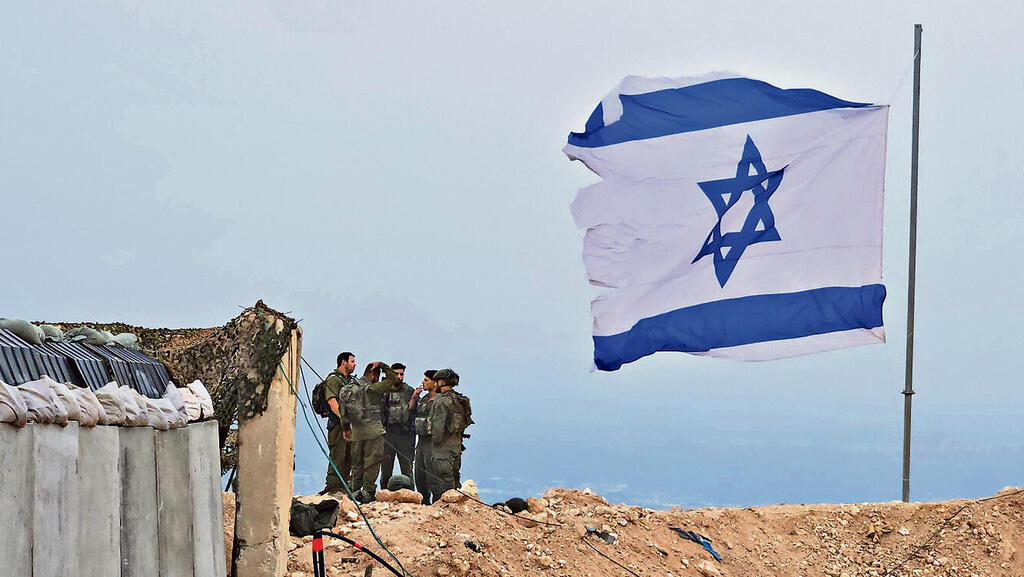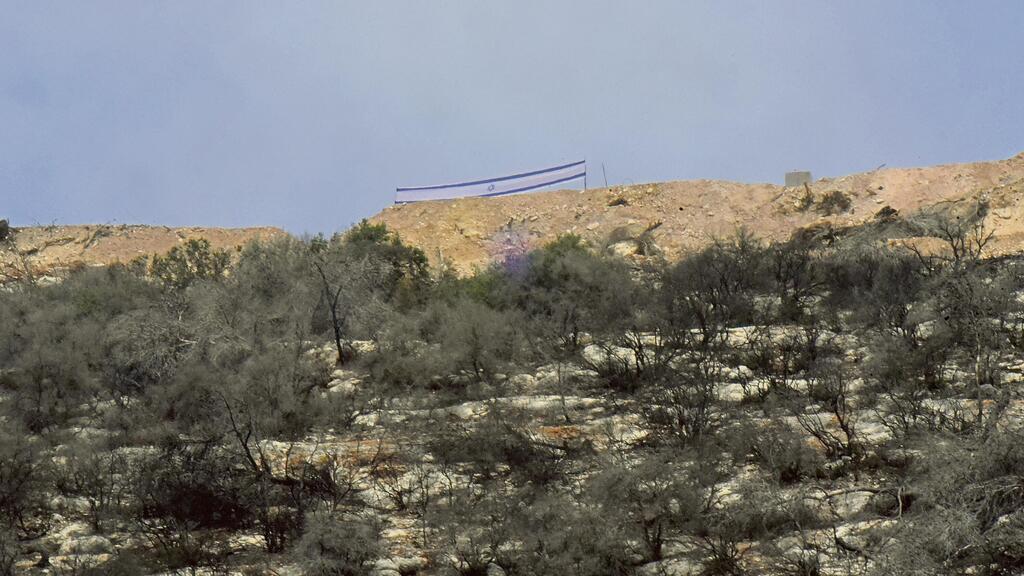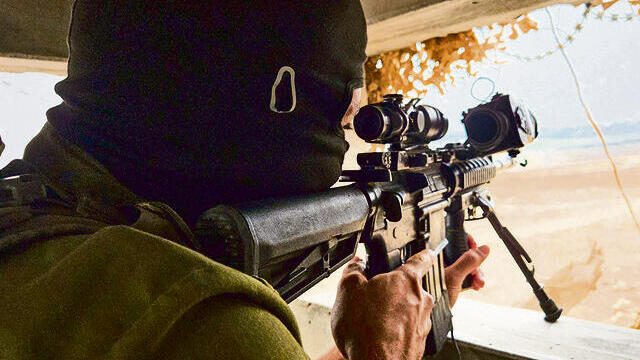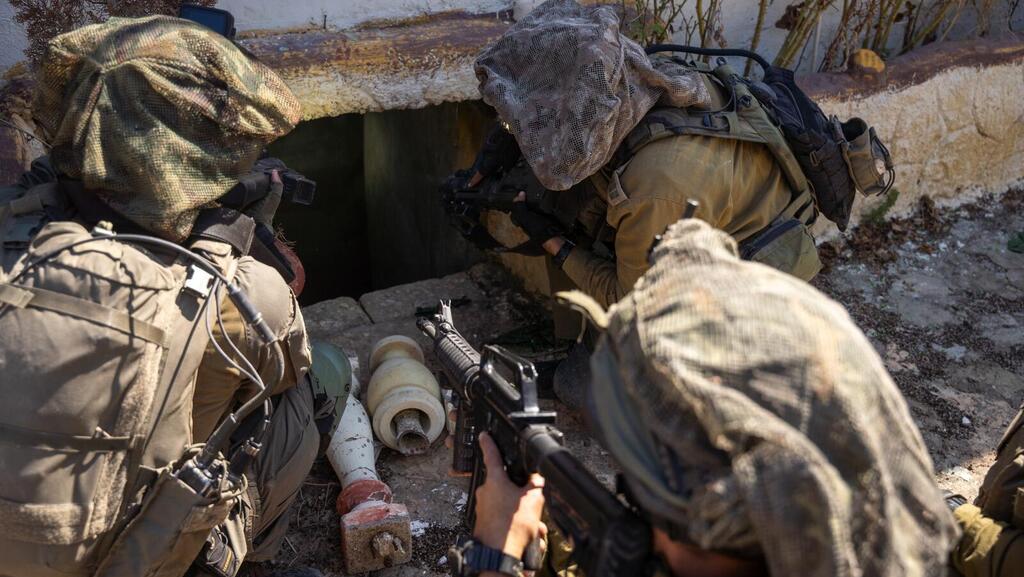In a show of presence near the northern border, the commander of the Carmeli Reserve Brigade, Col. (res.) D., recently ordered troops to hoist a massive Israeli flag over a newly established IDF outpost in southern Lebanon — the westernmost in the region — directly above homes in Shlomi.
The flag now hangs from the outpost’s southeastern edge, facing the Israeli side rather than looking north toward the Lebanese villages of Aalma El Chaeb and Naqoura.
It’s one of five positions forming a “mini-buffer zone” that the IDF is currently formalizing just across the border. The soldiers stationed there, mostly Golani Brigade veterans, intended the flag as a message to northern residents: We’re here, protecting you.
“Aalma El Chaeb is an interesting case,” said Maj. (res.) D. from the brigade, which led the IDF’s ground campaign in the area last year. “Unlike other villages in the sector, this one remains intact. Its residents didn’t let Hezbollah establish a presence and now they’re reaping the benefits.”
But Hezbollah, he added, is still close — just beyond reach — looking for a reason to remain relevant. “It’s only a matter of time before the Lebanese demand we withdraw and Hezbollah will use that to claim we’re occupying their land, just like it did with Shebaa Farms,” said one senior officer.
The outpost, officially named “Magen Yehuda” (Yehuda’s Shield), may get a new name: “Rotem,” a nod to the IDF position once located in the same area before Israel’s 2000 withdrawal. From where the flag is planted, atop a meeting point of earthen embankments, the outpost’s strategic value is clear.
Below lie the rooftops of Shlomit, exposed to fire from the Sullam Ridge. Just a few hundred meters (roughly 650–980 ft) east runs Wadi Qatiya, the most vulnerable infiltration route in the region — hidden between two ridgelines and notorious for past terrorist infiltrations. In 2002, Hezbollah terrorists used this exact path to enter Israel and kill six civilians near Kibbutz Matzuva.
Beneath the flag, a group of reservist officers is on a familiarization tour. Soon, they’ll replace the current Carmeli troops in a continuous cycle. “From here you can dominate vast areas with ease—villages, roads—not just Shlomi,” said Capt. R., the company commander, as we arrived.
“Just last week,” added Col. D., “I met residents from Shlomi and Hanita. They told me: ‘If that flag comes down, we’re leaving. It makes us feel safe — knowing the IDF is up there.’”
Italian forces watching us
No more than 200 meters (656 ft) of dirt road separate the outpost from a large opening in the border fence. Nearby is another exposed route leading east toward Aalma El Chaeb. On a clear day, one can see the city of Tyre to the north and the University of Haifa to the south.
“Seven months ago, this place looked totally different,” said Lt. Col. (res.) G., the battalion commander. “It was a fortified Hezbollah zone, full of weapons and launch sites disguised in the brush and buried underground. We exposed, located, and destroyed it all—but the work isn’t done.”
At the time, faces of soldiers like T. and D. were shown openly in media coverage. Families back home proudly recognized the men rarely seen at home. Today, they’re all pixelated or photographed from behind—identities obscured to avoid arrest abroad on suspicion of war crimes. Another surreal reality the troops have learned to live with.
I climbed up to the outpost from the abandoned, once-picturesque site of Rosh Hanikra—still closed during Passover. “They’re doing maintenance work there,” said Col. D., who fought on October 7 in Kibbutz Kfar Aza as commander of the elite Duvdevan Unit. “But the rest of the area was open and thriving.”
“Hezbollah is still here, watching, gathering intel,” said Capt. R., a contracts lawyer in civilian life. He was tasked with leading the initial briefing since both the battalion and brigade commanders were tied up investigating a recent weapons theft from another post. R. has been stationed here since February in what the IDF calls a “defensive battle.”
He takes pride in leading his troops through their fifth reserve rotation in just 18 months. They fought in the towns of Marwahin and Jabal Blat, and now watch their outpost expand.
Conditions are relatively comfortable: air-conditioned, fortified living containers, hot meals from field kitchens and shifts alternating between two hours on, six or eight off. The standard cycle is eight to ten days in the sector followed by four or five days at home—unlike Gaza border duty, there’s no week-on, week-off system here.
“This very spot used to be a Hezbollah position, with gear we don’t even have in our own storage,” said Lt. Col. J. “We’ve drawn red lines with the Lebanese—zones where they can and can’t go. Hezbollah’s trying to recover after taking a serious hit. We wiped out an entire Radwan Company—150 fighters—in this area.”
Overlooking the IDF post is a UN position, still relevant despite sharp criticism of UNIFIL. “There are Italians up there watching us,” said Capt. R. In recent months, Israel’s defense establishment has rallied every foreign presence it can—including UNIFIL—to maintain its gains and keep Hezbollah away.
Coordination with UNIFIL has improved significantly. A new U.S.-led oversight mechanism, staffed by just 15 officers in Beirut, is alerted to every IDF-detected violation. It relays reports to the Lebanese Army, which often dispatches troops to confiscate rockets or prevent attacks.
Get the Ynetnews app on your smartphone: Google Play: https://bit.ly/4eJ37pE | Apple App Store: https://bit.ly/3ZL7iNv
When they don’t respond quickly, the Israeli Air Force does—sometimes daily. Hundreds of Hezbollah operatives have been killed since the ceasefire began.
“Nothing is finalized,” added Capt. R., a silver Golani insignia glinting around his neck. “The lines are still forming. But my troops feel like they’re making history—despite the exhaustion and wear.”
The IDF's reserve 'supplements'
And the exhaustion is real — even in one of the IDF’s most committed and well-supported reserve brigades. During the war’s early days, the Carmeli Brigade saw over 100% turnout. Today it’s around 82%, compared to 50–60% in most reserve units.
“And that’s without ‘supplementals’—I don’t want them,” said Maj. T., using the term for reservists assigned to unfamiliar units. “They disrupt the unit’s cohesion.”
The growing reliance on such ‘supplementals’ reflects a deeper manpower crisis. As fighting drags on, the IDF must fill its ranks—and officers are now openly posting recruitment ads online.
In some battalions, entire platoons and companies are made up of these last-minute recruits—mostly young veterans still finding their way in civilian life. While the government offers generous financial incentives for reservists, no one wants to admit that’s part of the draw.
“Supplementals undermine camaraderie. They create units full of strangers, not brothers-in-arms,” said the experienced Maj. T. “It’s become a pandemic—and causes long-term damage. What holds people together is unit cohesion.”
Company commander Capt. R., a seasoned officer, began the current round of reserve duty by acknowledging the personal needs of each soldier: those who needed to stay home were released. Those who could, even if just for a week, came in, did a few shifts and went home.
“Some wives just couldn't bear the thought of their partner returning to reserve duty and risking his life again on the border, so we eased off,” a battalion officer said. “We told people, ‘This time, don’t come. Come next time instead.’ For the sake of peace at home—after many couples divorced during the war because of reserve duty.”
According to a brigade officer who previously served as a battalion commander, “Before October 7, a reserve battalion commander did 70 days a year. Now, that’s what a regular soldier does and we try not to exceed it. Officers here hardly see their homes. A battalion commander doesn’t take off his uniform.”
Until October 7, the regional 300th Brigade operated in the area stretching from Moshav Shomera to the sea. Today, even after more than six months of ceasefire, the number of forces on both sides of the fence has tripled. There's even a battalion stationed in the rear, inside Israeli territory, 5 to 6 kilometers (3.1 to 3.7 miles) from the border.
In the sector we’re currently in, significant forces are deployed with two brigades. This is a direct result of the trauma of October 7. But don’t be surprised if some of those forces are reduced in the coming year due to the limited resources and the continued quiet.
“This is a lot more than we've had over the years, and we’ll need to assess if it's too much,” adds battalion commander Lt. Col. T. “We’re now paying the price for the troop reductions that went on here for years.”
According to cautious estimates from Finance Ministry officials, Israeli taxpayers fund two and a half months of operational reserve duty for a single battalion at a cost of around NIS 20 million. And that’s just for the pay during reserve days — it doesn’t include the tens of thousands of shekels in benefits granted to each reservist.
Multiplied across several battalions over six months, the cost runs into billions. That’s why the IDF is pleading to enlist regular Haredi brigades to help ease the burden.
“You can throw money at us all day, but no one compensates us for the careers that are harmed and the promotions that never come because we’re not in the office. And we haven’t even talked about employers, who aren’t compensated at all,” says a reserve major in the brigade.
“As a contractor and structural engineer, I had to lay off 40 workers because I lost projects and received zero compensation. A company commander spends a third of his time convincing employers not to fire his soldiers—even in the public sector, like hospitals. But what can a manager do when his programmer or welder is only around half the time for over a year?”
“They say they’ve installed WeWork setups in the outposts so we can work from there. Not everyone can do that. There’s not always internet or cell service, and it’s way more complicated than people think. If a worker has an important Zoom meeting, is he supposed to drop it halfway through to respond to an alert?”
The battalion’s troops are increasingly struggling with exhausting security and guard duty tasks, and some are explicitly asking to be challenged. “The sector is still active. Just last month we blew up more Hezbollah bunkers with weapons,” says brigade commander Col. D.
“Our guys received new weapons and modern combat gear, which lifts their spirits. One outpost even has a router with internet access. The Technion, which has adopted the brigade, gives us a lot of support. We even send handymen to soldiers’ homes to fix things and take their cars for inspection.”
You enlisted in the IDF after Israel withdrew from the buffer zone in Lebanon but some of your troops served in other locations. Are you not concerned that you’re slipping into a dangerous routine that the enemy could exploit, like back then?
“The key word is adaptability. That’s what matters. I rotate sectors between the companies. We've re-learned concepts from the old days, like ‘penetrating outposts,’ and brought in Golani veterans who served in the security zone.
“We have overlapping fields of fire and line-of-sight between the outposts. A commander also has to be proactive — launch operations and not just sit in the post. Naturally there’s frustration when not everything gets approved. Even I get pushback when I go up the chain of command. But overall, we’ve got a lot of operational freedom.”
It turns out the Lebanese army is also active. “A few days ago, we notified them about a weapons cache we had identified, and they sent in a team to dismantle it,” the brigade commander recounts. “Had they not done that, we would’ve blown it up ourselves. They know I watched them do it with my drones tracking their every move.”
What worries you most?
“That Hezbollah isn’t responding, even though we’re hitting them a lot. I know my forward outposts will be the first targets if and when they do retaliate.”






